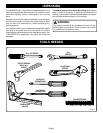
Page 8
Anti-Kickback Pawls (Fingers)
Device which, when properly installed and maintained, is
designed to stop the workpiece from being kicked back
toward the front of the saw during a ripping operation.
Arbor
The shaft on which a blade or cutting tool is mounted.
Bevel Cut
A cutting operation made with an angled blade.
Compound Cut
A cut with both a miter angle and a bevel angle.
Crosscut
A cutting or shaping operation made across the grain of the
workpiece.
Dado
A non-through cut which produces a square sided notch or
trough in the workpiece.
Featherboard
A device used to help control the workpiece by guiding it
securely against the table or fence during any rip cut operation.
Freehand
Performing a cut without using a fence, miter gauge, fixture,
hold down clamp, or other proper device to keep the workpiece
from twisting during the cut.
Gum
A sticky, sap based residue from wood products.
Heel
Misalignment of the blade.
Kerf
The amount of material removed by the blade in a through
cut or the slot produced by the blade in a non-through or
partial cut.
Kickback
An uncontrolled grabbing and throwing of the workpiece
back toward the front of the saw. Associated with the
workpiece closing the kerf and pinching the blade or otherwise
placing tension on the blade.
Leading End
The end of the workpiece which, during a rip type operation,
is pushed into the cutting tool first.
Miter Cut
A cutting operation made with the wood at any angle other
than 90 degrees.
Molding
A cut which produces a special shape in the workpiece, used
for joining or decoration.
Non-Through Cuts
Any cutting operation where the blade does not extend
completely through the thickness of the workpiece.
Push Block
A device used to feed the workpiece through the saw, except
during narrow ripping type operations where a push stick
should be used. It also helps keep the operator's hands well
away from the blade.
Push Stick
A device used to feed the workpiece through the saw to help
keep the operator's hands well away from the blade.
Rabbet
A notch in the edge of a workpiece.
Resin
A sticky, sap base substance that has hardened.
Ripping Or Rip Cut
A cutting or shaping operation made along the length or with
the grain of the workpiece.
Riving Knife
Also known as a spreader or splitter. A metal piece, slightly
thinner than the saw blade which helps keep the kerf open
and prevent kickback.
Revolutions Per Minute (RPM)
The number of turns completed by a spinning object in one
minute.
Saw Blade Path
The area over, under, behind, or in front of the blade. As it
applies to the workpiece, that area which will be, or has been,
cut by the blade.
Set
The distance that the tip of the sawblade tooth is bent (or set)
outward from the face of the blade.
Throw-Back
Throwing of a workpiece in a manner similar to a kickback.
Usually associated with a cause other than the kerf closing,
such as a workpiece being dropped onto the blade or being
placed inadvertently in contact with the blade.
Through Sawing
Any cutting operation where the blade extends completely
through the thickness of the workpiece.
Trailing End
The workpiece end last cut by the blade in a ripping operation.
Workpiece
The item on which the cutting operation is being done. The
surfaces of a workpiece are commonly referred to as faces,
ends, and edges.
GLOSSARY OF TERMS


















